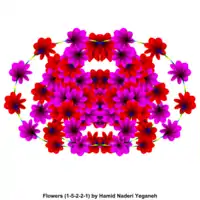اس.ال. حکیمی
سیفالله لوئیس حکیمی (زاده ۱۹۳۲ در مشهد - درگذشته ۲۳ ژوئن ۲۰۰۵)[1] ریاضیدان آمریکایی ایرانیتبار بود. استاد ممتاز بازنشسته در دانشگاه نورث وسترن، جایی که او ریاست بخش مهندسی برق از سال ۱۹۷۳ تا سال ۱۹۷۸ را برعهده داشت.[2] او نیز رئیس بخش مهندسی برق در دانشگاه کالیفرنیا، دیویس، از سال ۱۹۸۶ تا ۱۹۹۶ بود.[1]
او برای توصیف دنباله های درجه ای گراف های بی جهت[3]، به فرمول درآوردن مسئله درخت اشتاینر در شبکه ها[4]، و برای کارش روی مکانیابی تسهیلات در شبکه ها شناخته شده است.[5]
منابع
- Pat Bailey (July 21, 2006). "Harold Olmo: Pioneering wine, grape scientist, and other obituaries". UCDavis. Retrieved 29 August 2017.
- Fine, Morris E. (ed.), Tech, the early years: An anthology of the history of the technological institute at Northwestern University from 1939 to 1969 (PDF), p. 103, archived from the original (PDF) on 2013-12-03.
- Allenby, R.B.J.T.; Slomson, Alan (2011), "Theorem 9.3: the Havel–Hakimi theorem", How to Count: An Introduction to Combinatorics, Discrete Mathematics and Its Applications (2nd ed.), CRC Press, p. 159, ISBN 9781420082616,
A proof of this theorem was first published by Václav Havel ... in 1963 another proof was published independently by S. L. Hakimi
. - Hwang, F. K.; Richards, D. S.; Winter, P. (1992), The Steiner Tree Problem, Annals of Discrete Mathematics, Elsevier, p. 94, ISBN 9780080867939,
The Steiner tree problem in networks was originally formulated by Hakimi and independently by Levin in 1971.
- Marianov, Vladimir; Serra, Daniel (2011), "Median problems in networks", in Eiselt, Horst A.; Marianov, Vladimir, Foundations of Location Analysis, International series in operations research & management science, 155, Springer, pp. 39–59, doi:10.1007/978-1-4419-7572-0_3, ISBN 9781441975720. On p. 53, Marianov and Serra write "The impact of Hakimi's two contributions is hard to overstate. A common opinion among location researchers is that the paper by Hakimi (1964) strongly contributed to trigger the interest in location theory and analysis, and started a long string of related publications that does not seem to be decreasing."
This article is issued from Wikipedia. The text is licensed under Creative Commons - Attribution - Sharealike. Additional terms may apply for the media files.

